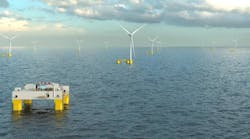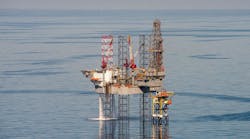Paul Groves
Petrofac Training Services
A voice comes over the radio. The pilot of an inbound helicopter is just two minutes away from the offshore installation and is experiencing vibrations. He has lost control and is preparing to make a hard landing. The installation’s Control Room operator reports news of the confirmed emergency to the offshore installation manager (OIM) and the control room team. As the team musters in the control room, the unmistakeable sound of an approaching helicopter is followed by a thunderous crash and explosion as scraps of metal and debris collide on the helideck. A multiple casualty incident just occurred. The emergency response effort in the minutes that follow will be critical to the outcome and severity of the crisis situation.
Participants during role-play scenarios.
Now imagine having the opportunity to role play the emergency response efforts. Simulate in a controlled, monitored environment the experience of a helicopter crash, but without the actual disaster. That is exactly what Major Emergency Management (MEM) training is designed to do. The course, offered by Petrofac Training Services, helps emergency managers and teams develop the core competencies required in a crisis – effective leadership, decision making, delegation, communication, team work, and stress management – by enacting simulated emergency response exercises. MEM training has emerged globally to become a core safety training offering for oil and gas personnel with emergency response roles. The course uses a simulation suite fully equipped with IT and audio-visual capabilities to replicate the same sights, sounds, and stresses experienced during an emergency.
The training typically lasts four to five days, depending on the training provider and the employer’s requirements. The course can be customized for operators or drilling and service companies, whether onshore or offshore, by incorporating specific facility models such as mobile offshore drilling units and fixed or floating production facilities, onshore terminals, and refineries.
The classroom, theory-based portion of the course covers topics such as emergency preparedness and stress management; while the practical, hands-on portion enacts simulated emergency scenarios in which participants take turns in the various emergency team roles – including the emergency manager, often called the OIM, Person In Charge, or on-scene commander.
Scenarios vary in complexity and can range from loss of communication, to asset damage, to missing personnel. Some scenarios are designed to be controllable if properly managed; others are intended to require facility evacuation.
To make scenarios as realistic as possible, the exercises take place in a simulated, staged control room or command center to create interactive process and operating systems. The scenarios incorporate the use of Emergency Response Plans (ERPs), work permits, radios, alarms, and information boards to further heighten realism. Courses can use generic props or be tailored to an employer’s requirements, often using the same facility designs, station bills, POB lists, and ERPs.
After each scenario, a de-briefing is held to review what went well and what could be improved for the individual and the team. A key to the course is that it continually measures the ability of the participant to perform emergency management duties to a specified standard by incorporation of an appraisal process. The appraisal process also is customized to the employer’s needs, ranging from informal assessments to full-scale appraisals in which trained assessors evaluate participants.
Evolution of MEM
Many lessons stem from the Piper Alpha disaster in 1988 which claimed the lives of 167 of the 229 crew members on board the North Sea installation and brought about sweeping changes to offshore safety regulations in the UK. One such lesson was the unmistakable need for increased crisis situation training for offshore managers.
Following the Piper Alpha disaster, a new safety case regime was introduced in the UK. In 1992, regulations were introduced which require every Duty Holder of an installation on the UK continental shelf to document and submit how its safety management system would mitigate the risks associated with its operations. One requirement of the safety case is the need for the Duty Holder to demonstrate that its offshore managers are competent to lead in an emergency situation. This requirement further specifies that managers should be assessed in their ability to command in an emergency.
MEM training was developed later to help the industry meet these new requirements. The UK Offshore Operators Association worked to establish guidelines and a standard-setting industry body then developed a training standard for the course and the appraisal process.
Since theDeepwater Horizon incident on April 20, 2010, which resulted in the loss of 11 lives, US regulators have worked to bring about effective safety reforms. The Department of the Interior is reviewing the safety case approach, which, since implementation in the UK, has been put in place by a number of oil-producing countries around the globe.
It is still too early to tell whether the US will adopt a safety case approach and what the possible requirements might entail. Regardless of the regulatory changes to come in the US, companies will need to develop comprehensive plans to mitigate risks and hazards. The need for safety training such as MEM is likely to be considered. Many companies operating in the US already have an internal training requirement for their emergency mangers to complete the course which is seen as an internal best practice.
Market trends
Petrofac Training Services has delivered MEM training for nearly 20 years and has seen demand for the course double across its global operations in 2010. In the US, a second MEM simulation suite was opened at the company’s Houston Training Center to better support the increased demand.
A number of international operating and drilling companies have set internal standards for the training. For example, one oil operator has plans to move to a standardized course delivery by requiring designated emergency managers, regardless of geographic location, to complete MEM training that is approved by a standard-setting industry body.
In addition, a number of companies are sending members of extended onshore support teams to the training as well as their emergency managers. In the US, Petrofac Training Services recently created a condensed version of the training to give exposure to those response personnel who will never manage an emergency but will play a role in response efforts.
Benefits of MEM
The effectiveness of the course is due largely to the fact that all the core competencies of an emergency manager are tested. Participants must practice their ability to assess the situation, take action while under pressure, and implement emergency response plans while effectively maintaining communication and delegating authority.
Course participants often cite increased confidence in their ability to make decisions under pressure after successful completion of the training. On the other hand, participants who are found “not yet competent” after an appraisal are given the support, training, and development opportunities needed to close any competence gaps.
Another common response from participants is their realization that effective team work is critical. One person cannot manage all the moving parts in an emergency. A team must be relied upon to share information and carry out actions. While each role plays a distinct and critical part, the team’s interaction drastically impacts how effective it will be at emergency escalation prevention.
Because there will always be risks and hazards in the oil and gas industry, regulators and the industry must continue to learn from lessons of the past and work together to ensure the highest levels of safety and emergency response. It is a positive sign that the demand for MEM training continues to increase, as this important safety training helps the world’s emergency managers develop the competencies needed to effectively manage emergency situations.
Offshore Articles Archives
View Oil and Gas Articles on PennEnergy.com






